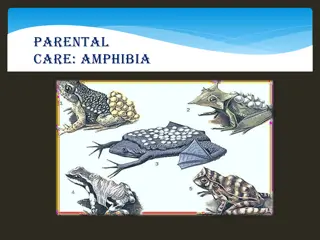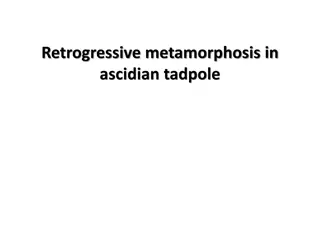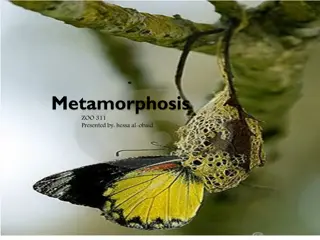Amphibian Metamorphosis: A Dive into Developmental Changes
Amphibian metamorphosis marks the transition from larval aquatic life to adult terrestrial existence. The process involves morphological transformations including tail resorption, gill destruction, and skin structure changes. Key changes in urodeles (salamanders) and anurans (frogs/toads) are outlined, highlighting the shift in habitat, anatomy, and physiology. Hormonal control by thyroxin orchestrates metamorphosis, regulating tissue changes and organ degradation post-transformation. Biochemical alterations, such as photopigment and hemoglobin shifts, accompany this intricate developmental stage in amphibians.
Uploaded on Aug 01, 2024 | 4 Views
Download Presentation

Please find below an Image/Link to download the presentation.
The content on the website is provided AS IS for your information and personal use only. It may not be sold, licensed, or shared on other websites without obtaining consent from the author.If you encounter any issues during the download, it is possible that the publisher has removed the file from their server.
You are allowed to download the files provided on this website for personal or commercial use, subject to the condition that they are used lawfully. All files are the property of their respective owners.
The content on the website is provided AS IS for your information and personal use only. It may not be sold, licensed, or shared on other websites without obtaining consent from the author.
E N D
Presentation Transcript
AMPHIBIAN METAMORPHOSIS METAMORPHOSIS :- the transition from a larval stage to an adult stage. MORPHOLOGICAL CHANGES ASSOCIATED WITH METAMORPHOSIS :- In amphibian, habitat changes from aquatic to the terrestrial.
In urodeles (salamander):- These changes include the o resorption of tail fin. o The destruction of the external gills. o Changes in the skin structure. In Anurans (frog and toad):- The metamorphic changes are more dramatic .
Metamorphic changes in anurans system larva adult Locomotory Aquatic : tail fins Terrestrial: tailless tetrapod (due to higher conc. Of Thyroxin) Respiratory Gills, skin, lungs, haemoglobins. Lungs; adult haemoglobin. Circulatory Aortic arches; aorta , anterior and posterior or common jugular veins. Carotid arch , systemic arch cardinal veins. Nutrition Herbivorous Long spiral gut, Small mouth, Horny jaws ,Labial teeth Carnivorous Short gut Large mouth with long tongue. Excretory Largely ammonia, some urea (ammonotelic) Largrly urea; high actuality of enzymes of ornithine urea cycle ( ureotelic) Integumental Thin , bilayered epidermis with thin epidermis ; no mucous gland or granular gland. Stratified squamous epidermis with adult keratins;well developed dermis contain mucous and granular gland.
Metamorphosis in amphibians is regulated by Thyroxin concentration in the blood which stimulates metamorphosis- which counteracts its effects. Specific events are dependent on threshold values for different tissue, because most embryonic development is subjected to specific ecological circumstance. After metamorphosis these organs become redundant and will be reabsorbed by controlled cell death called apoptosis.
BIOCHEMICAL CHANGES In tadpoles, ;- major retinol photopigment is porphyropin changes into the rhodopsin during metamorphosis. Tadpole haemoglobin changes into the adult haemoglobin that binds with oxygen more slowly Tadpole are ammonotelic adult ureotelic.
HORMONAL CONTROL The control of metamorphosis by thyroid hormone was demonstrate by Guder-natch(1912) The metamorphic changes of frog development are all brought about by the secretion of hormones Thyroxin (T-4) and Triiodothyronine(T-3) from the thyroid during metamorphosis . It is thought that T-3 is the more important hormone, as it will cause metamorphic changes in thyroidectomized tadpole in much lower concentration than (T-4).























